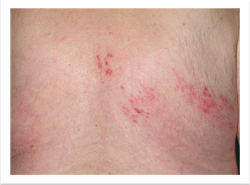SERVICES
- Allergy Screening
- Chemical Peels
- Dermapen
- Facial Skin Analysis
- FreshEyes
- Hyperhidrosis (Excessive Sweating)
- Hair Loss Treatment
- Laser Clinic
- Liquid Facelift
- Keloid Treatments
- Medical Facials
- Medical Treatments
- Mole Mapping
- Photodynamic Therapy (PDT)
- Skincare Advice
- Pigmentation Treatment
- Surgical Procedures
- Ultraviolet Phototherapy
USEFUL LINKS
What is shingles?
 Shingles (also known as herpes zoster) is a painful blistering rash caused by the same virus that causes chickenpox (the varicella zoster virus).
Shingles (also known as herpes zoster) is a painful blistering rash caused by the same virus that causes chickenpox (the varicella zoster virus).
What causes shingles?
If you have had chickenpox the virus that caused it may live on afterwards in a dormant state in the nerves linked to your spinal cord. If the virus becomes active again, it will multiply and move along the nerve fibres to the area of skin supplied by those nerves; shingles then appears in this area. About 20% of people who have had chickenpox will have an attack of shingles later in life.
Shingles is not caught from someone who has shingles, but follows an earlier attack of chickenpox. However, a person with shingles can infect someone who has never had chickenpox, causing an attack of chickenpox but not shingles. Most attacks of shingles occur for no obvious reason, but an attack is more likely if:you are
- Elderly
- You are under stress
- You have an illness that weakens the immune system, such as leukaemia, a lymphoma (for example, Hodgkin’s disease), or HIV
- You are taking treatments that suppress the immune system, including irradiation for cancer, chemotherapy, cortisone-like drugs, and drugs taken to prevent organ rejection
Is shingles hereditary?
No.
What are the symptoms of shingles?
Pain is the first and predominant symptom and sometimes there is also a tingling or burning sensation. The rash usually appears a day or two after these symptoms. You may also feel ill and have a fever and a headache.
What does shingles look like?
The first sign is the appearance of groups of red spots on a pink-red background, which quickly turn into small fluid-filled blisters. Some of the blisters burst, others fill up with blood or pus. The area then slowly dries out, and crusts and scabs form. The scabs will drop off over the next 2-3 weeks.
The rash usually covers a well-defined area of skin on one side of the body only, and not crossing the midline. Its position and shape will depend on which nerves are involved. Shingles can affect any area, but common patterns include a band running round one side of the chest, or down an arm or leg. Sometimes pale or dark scars follow shingles, particularly after a severe attack.
A chickenpox-like rash occasionally comes up at the same time as shingles. This may indicate a more serious and widespread attack of shingles or that there is an underlying reason for the shingles.
How is shingles diagnosed?
Early in the course of shingles, before the rash is present, it may be difficult to make the diagnosis. Later on the diagnosis is usually straightforward, based on the story of pain appearing before the rash, and on the typical appearance of the rash.
It takes several days to grow the virus in the laboratory to test for shingles so it is not often done as treatment needs to be started quickly. If there is doubt about the diagnosis, scrapings may be taken from a blister and looked at under a microscope.
Can shingles be cured?
- Shingles resolves on its own within a few weeks. Oral medication can make the rash of shingles clear more quickly and can reduce its unpleasant effects. These effects depend largely on which nerve is involved:
- Shingles of the area served by the nerve that carries sensation from the front of the eye can lead to ulceration there, and later to scarring. Blisters coming up on the side of your nose will alert your doctor to this risk, and you should get advice from an eye specialist.
- Muscles supplied by the nerves taking part in the shingles occasionally become weak. For example, a temporary facial paralysis can accompany a shingles rash on the ear.
The pain of shingles may persist long after the rash has cleared (post herpetic neuralgia), particularly in the elderly. Usually this goes away within 6 months, but a few people are in pain for a year or more.
How can shingles be treated?
The goals of treatment are:
- To shorten the attack. Antiviral drugs (such as aciclovir, famciclovir and valaciclovir) are safe and can do this, but only if they are given within the first few days of an attack.
- To make it less painful. Rest and taking pain-killers (for example, paracetamol) may help.
- To deal with complications. A bacterial infection complicating shingles may require an antibiotic cream or tablets. Eye involvement will need a specialist ophthalmic review, and eye drops may be prescribed.
- To prevent postherpetic neuralgia. Using an anaesthetic ointment (lidocaine 5%) before applying capsaicin cream may help. Taking antiviral drugs during an attack of shingles may reduce the risk of getting postherpetic neuralgia, and shortens its duration if it does occur.
- To treat the pain of postherpetic neuralgia. Treatments that are sometimes used include antidepressants, such as amitryptiline, and anticonvulsants, such as carbamazepine, as well as pain killers, such as non-steroidal anti-inflammatories.
What can I do?
Since newborn babies or people with reduced immunity could catch chickenpox from the shingles, do not allow them to come into contact with the affected area.
You should see your doctor as early as possible if you think you have shingles, particularly of the face, as antiviral treatment works best if taken early in an attack.
You may need to take 2 or 3 weeks off work.
Patient Testimonials
EXCELLENTTrustindex verifies that the original source of the review is Google. From my first visit with Dr Jhetam I knew I would go back. He is compassionate , friendly and has an interaction which made you feel comfortable. This is very important in any doctor because our relationship with our doctor is very intimate.Posted onTrustindex verifies that the original source of the review is Google. Dr Jhetman is truly one of a kind. Anyone who is fortunate enough to be in his care can so grateful. Academic, informative and reassuring. It’s hard to find a doctor who has this combination of skills these days. He dealt with my Melonoma concerns with swift and professional care. And his staff are equally as competent and caring. I cannot commend Dr Jhetman and his staff enough on true patient care. Thank you!Posted onTrustindex verifies that the original source of the review is Google. I was absolutely satisfied with my experience with Dr Jhetham & his winning team. Keep up the good work.Posted onTrustindex verifies that the original source of the review is Google. Best skin doctor..Dr Jetham prescribed the best products that have brought so much of a glow to my skin..being a transplant patient and so much happening to my skin just 4 visits to him and my face is back to it's radiance ..I hightly reccomend Dr Jetham ...you won't go wrong..Posted onTrustindex verifies that the original source of the review is Google. Dr. Imraan Jhetam and his team provided exceptional care, showcasing professionalism and compassion in every interaction. Dr. Jhetam took the time to thoroughly explain everything, addressing each of my concerns with empathy and understanding. My experience with him was truly wonderful, and I highly appreciate his dedication to patient care.Verified by TrustindexTrustindex verified badge is the Universal Symbol of Trust. Only the greatest companies can get the verified badge who has a review score above 4.5, based on customer reviews over the past 12 months. Read more



